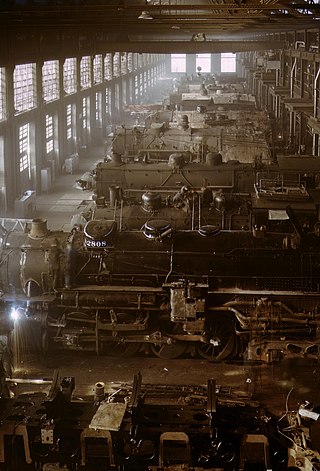
Rural flight is the migratory pattern of people from rural areas into urban areas. It is urbanization seen from the rural perspective.
Import substitution industrialization (ISI) is a trade and economic policy that advocates replacing foreign imports with domestic production. It is based on the premise that a country should attempt to reduce its foreign dependency through the local production of industrialized products. The term primarily refers to 20th-century development economics policies, but it has been advocated since the 18th century by economists such as Friedrich List and Alexander Hamilton.

Industrialisation (UK) or industrialization (US) is the period of social and economic change that transforms a human group from an agrarian society into an industrial society. This involves an extensive reorganisation of an economy for the purpose of manufacturing. Industrialisation is associated with increase of polluting industries heavily dependent on fossil fuels. With the increasing focus on sustainable development and green industrial policy practices, industrialisation increasingly includes technological leapfrogging, with direct investment in more advanced, cleaner technologies.

In sociology, an industrial society is a society driven by the use of technology and machinery to enable mass production, supporting a large population with a high capacity for division of labour. Such a structure developed in the Western world in the period of time following the Industrial Revolution, and replaced the agrarian societies of the pre-modern, pre-industrial age. Industrial societies are generally mass societies, and may be succeeded by an information society. They are often contrasted with traditional societies.

Subsistence agriculture occurs when farmers grow crops on smallholdings to meet the needs of themselves and their families. Subsistence agriculturalists target farm output for survival and for mostly local requirements. Planting decisions occur principally with an eye toward what the family will need during the coming year, and only secondarily toward market prices. Tony Waters, a professor of sociology, defines "subsistence peasants" as "people who grow what they eat, build their own houses, and live without regularly making purchases in the marketplace".

The people's commune was the highest of three administrative levels in rural areas of the People's Republic of China during the period from 1958 to 1983, until they were replaced by townships. Communes, the largest collective units, were divided in turn into production brigades and production teams. The people's commune collectivized living and working practices. Many individual homes were abolished in favour of communal residences, with many houses taken apart and demolished. Regardless of age or relationship, many men and women lived separately, and often, multiple families were placed in the same communal homes. One's land, tools, resources were pooled together, with working hours and farming practices completely dictated by the CCP.
In the mid-1980s, Communist Czechoslovakia was prosperous by the standards of the Eastern Bloc, and did well in comparison to many richer western countries. Consumption of some goods like meat, eggs and bread products was even higher than the average countries in Western Europe, and the population enjoyed high macroeconomic stability and low social friction. Inhabitants of Czechoslovakia enjoyed a standard of living generally higher than that found in most other East European countries. Heavily dependent on foreign trade, the country nevertheless had one of the Eastern Bloc's smallest international debts to non-socialist countries.

The economic history of France involves major events and trends, including the elaboration and extension of the seigneurial economic system in the medieval Kingdom of France, the development of the French colonial empire in the early modern period, the wide-ranging reforms of the French Revolution and the Napoleonic Era, the competition with the United Kingdom and other neighboring states during industrialization and the extension of imperialism, the total wars of the late-19th and early 20th centuries, and the introduction of the welfare state and integration with the European Union since World War II.

Articles in economics journals are usually classified according to JEL classification codes, which derive from the Journal of Economic Literature. The JEL is published quarterly by the American Economic Association (AEA) and contains survey articles and information on recently published books and dissertations. The AEA maintains EconLit, a searchable data base of citations for articles, books, reviews, dissertations, and working papers classified by JEL codes for the years from 1969. A recent addition to EconLit is indexing of economics journal articles from 1886 to 1968 parallel to the print series Index of Economic Articles.
Some economic historians use the term merchant capitalism, a term coined by the German sociologist and economist Werner Sombart in his "The Genesis of Modern Capitalism" in 1902, to refer to the earliest phase in the development of capitalism as an economic and social system. However, others argue that mercantilism, which has flourished widely in the world without the emergence of systems like modern capitalism, is not actually capitalist as such.
The economic history of China describes the changes and developments in China's economy from the founding of the People's Republic of China (PRC) in 1949 to the present day. The speed of China's transformation in this period from one of the poorest countries to one of the world's largest economies is unmatched in history.

An economy is an area of the production, distribution and trade, as well as consumption of goods and services. In general, it is defined as a social domain that emphasize the practices, discourses, and material expressions associated with the production, use, and management of resources. A given economy is a set of processes that involves its culture, values, education, technological evolution, history, social organization, political structure, legal systems, and natural resources as main factors. These factors give context, content, and set the conditions and parameters in which an economy functions. In other words, the economic domain is a social domain of interrelated human practices and transactions that does not stand alone.

The Great Divergence or European miracle is the socioeconomic shift in which the Western world overcame pre-modern growth constraints and emerged during the 19th century as the most powerful and wealthy world civilizations, eclipsing previously dominant or comparable civilizations from the Middle East and Asia such as Qing China, Mughal India, the Ottoman Empire, Safavid Iran, and Tokugawa Japan, among others.

Family economics applies economic concepts such as production, division of labor, distribution, and decision making to the family. It is used to explain outcomes unique to family—such as marriage, the decision to have children, fertility, time devoted to domestic production, and dowry payments using economic analysis.

Industrialization in the Soviet Union was a process of accelerated building-up of the industrial potential of the Soviet Union to reduce the economy's lag behind the developed capitalist states, which was carried out from May 1929 to June 1941.
The Industrious Revolution was a period in early modern Europe lasting from approximately 1600 to 1800 in which household productivity and consumer demand increased despite the absence of major technological innovations that would mark the later Industrial Revolution. Proponents of the Industrious Revolution theory argue that the increase in working hours and individual consumption traditionally associated with the Industrial Revolution actually began several centuries earlier, and were largely a result of choice rather than coercion. The term was originally coined by the Japanese demographic historian Akira Hayami to describe Japan during the Tokugawa era. The theory of a pre–industrial Industrious Revolution is contested by some historians.

The Mexican miracle is a term used to refer to the country's inward-looking development strategy that produced sustained economic growth. It is considered to be a golden age in Mexico's economy in which the Mexican economy grew 6.8% each year. It was a stabilizing economic plan which caused an average growth of 6.8% and industrial production to increase by 8% with inflation staying at only 2.5%. Beginning roughly in the 1940s, the Mexican government would begin to roll out the economic plan that they would call "the Mexican miracle," which would spark an economic boom beginning in 1954 spanning some 15 years and would last until 1970. In Mexico, the Spanish economic term used is "Desarrollo estabilizador" or "Stabilizing Development."

The economy of the Soviet Union was based on state ownership of the means of production, collective farming, and industrial manufacturing. An administrative-command system managed a distinctive form of central planning. The Soviet economy was characterized by state control of investment, prices, a dependence on natural resources, lack of consumer goods, little foreign trade, public ownership of industrial assets, macroeconomic stability, low unemployment and high job security.
Soviet-type economic planning (STP) is the specific model of centralized planning employed by Marxist–Leninist socialist states modeled on the economy of the Soviet Union (USSR).

The economy of the Socialist Republic of Romania was centrally planned, similar to the one of the Soviet Union. Most of the means of production were owned by the state, which established production plans as part of the Five-Year Plans.











